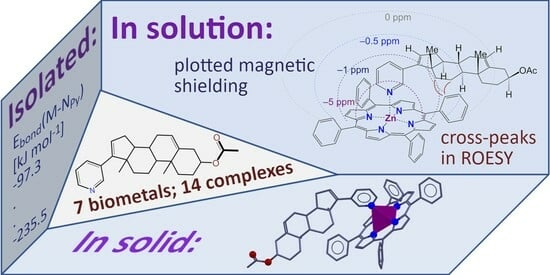Abiraterone Acetate Complexes with Biometals: Synthesis, Characterization in Solid and Solution, and the Nature of Chemical Bonding
Abstract
:1. Introduction
2. Materials and Methods
2.1. General Procedures
2.2. Crystallographic Details
2.3. DFT Calculations
3. Results
3.1. Synthesis
3.2. Molecular and Crystal Structures
3.3. Bond Energies
3.4. Structure in Solution
4. Conclusions
Supplementary Materials
Author Contributions
Funding
Institutional Review Board Statement
Informed Consent Statement
Data Availability Statement
Acknowledgments
Conflicts of Interest
References
- Paulekuhn, G.S.; Dressman, J.B.; Saal, C. Trends in Active Pharmaceutical Ingredient Salt Selection Based on Analysis of the Orange Book Database. J. Med. Chem. 2007, 50, 6665–6672. [Google Scholar] [CrossRef] [PubMed]
- Berge, S.M.; Bighley, L.D.; Monkhouse, D.C. Pharmaceutical Salts. J. Pharm. Sci. 1977, 66, 1–19. [Google Scholar] [CrossRef] [PubMed]
- Wermuth, C.G.; Stahl, P.H. Pharmaceutical Salts, Properties, Selection, and Use. A Handbook; Helvetica Chimica Acta/Wiley-VCH: Weinheim, Germany, 2001; ISBN 978-3-906390-26-0. [Google Scholar]
- Fini, A.; Fazio, G.; Hervás, M.-J.F.; Holgado, M.A.; Rabasco, A.M. Factors Governing the Dissolution of Diclofenac Salts. Eur. J. Pharm. Sci. 1996, 4, 231–238. [Google Scholar] [CrossRef]
- Braga, D.; Grepioni, F.; Maini, L.; Prosperi, S.; Gobetto, R.; Chierotti, M.R. From Unexpected Reactions to a New Family of Ionic Co-Crystals: The Case of Barbituric Acid with Alkali Bromides and Caesium Iodide. Chem. Commun. 2010, 46, 7715–7717. [Google Scholar] [CrossRef] [PubMed]
- Braga, D.; Grepioni, F.; Lampronti, G.I.; Maini, L.; Turrina, A. Ionic Co-Crystals of Organic Molecules with Metal Halides: A New Prospect in the Solid Formulation of Active Pharmaceutical Ingredients. Cryst. Growth Des. 2011, 11, 5621–5627. [Google Scholar] [CrossRef]
- Grepioni, F.; Wouters, J.; Braga, D.; Nanna, S.; Fours, B.; Coquerel, G.; Longfils, G.; Rome, S.; Aerts, L.; Quéré, L. Ionic Co-Crystals of Racetams: Solid-State Properties Enhancement of Neutral Active Pharmaceutical Ingredients via Addition of Mg2+ and Ca2+ Chlorides. CrystEngComm 2014, 16, 5887–5896. [Google Scholar] [CrossRef]
- Surov, A.O.; Drozd, K.V.; Ramazanova, A.G.; Churakov, A.V.; Vologzhanina, A.V.; Kulikova, E.S.; Perlovich, G.L. Polymorphism of Carbamazepine Pharmaceutical Cocrystal: Structural Analysis and Solubility Performance. Pharmaceutics 2023, 15, 1747. [Google Scholar] [CrossRef]
- Meggers, E. Targeting Proteins with Metal Complexes. Chem. Commun. 2009, 1001–1010. [Google Scholar] [CrossRef]
- Blanck, S.; Maksimoska, J.; Baumeister, J.; Harms, K.; Marmorstein, R.; Meggers, E. The Art of Filling Protein Pockets Efficiently with Octahedral Metal Complexes. Angew. Chem. Int. Ed. 2012, 51, 5244–5246. [Google Scholar] [CrossRef]
- Delori, A.; Friščić, T.; Jones, W. The Role of Mechanochemistry and Supramolecular Design in the Development of Pharmaceutical Materials. CrystEngComm 2012, 14, 2350–2362. [Google Scholar] [CrossRef]
- Ma, Z.; Moulton, B. Supramolecular Medicinal Chemistry: Mixed-Ligand Coordination Complexes. Mol. Pharm. 2007, 4, 373–385. [Google Scholar] [CrossRef] [PubMed]
- Braga, D.; Grepioni, F.; André, V.; Duarte, M.T. Drug-Containing Coordination and Hydrogen Bonding Networks Obtained Mechanochemically. CrystEngComm 2009, 11, 2618–2621. [Google Scholar] [CrossRef]
- Chow, E.H.H.; Strobridge, F.C.; Friščić, T. Mechanochemistry of Magnesium Oxide Revisited: Facile Derivatisation of Pharmaceuticals Using Coordination and Supramolecular Chemistry. Chem. Commun. 2010, 46, 6368–6370. [Google Scholar] [CrossRef]
- McKinlay, A.C.; Morris, R.E.; Horcajada, P.; Férey, G.; Gref, R.; Couvreur, P.; Serre, C. BioMOFs: Metal–Organic Frameworks for Biological and Medical Applications. Angew. Chem. Int. Ed. 2010, 49, 6260–6266. [Google Scholar] [CrossRef] [PubMed]
- Horcajada, P.; Serre, C.; Vallet-Regí, M.; Sebban, M.; Taulelle, F.; Férey, G. Metal–Organic Frameworks as Efficient Materials for Drug Delivery. Angew. Chem. 2006, 118, 6120–6124. [Google Scholar] [CrossRef]
- Keskin, S.; Kızılel, S. Biomedical Applications of Metal Organic Frameworks. Ind. Eng. Chem. Res. 2011, 50, 1799–1812. [Google Scholar] [CrossRef]
- An, J.; Geib, S.J.; Rosi, N.L. Cation-Triggered Drug Release from a Porous Zinc–Adeninate Metal–Organic Framework. J. Am. Chem. Soc. 2009, 131, 8376–8377. [Google Scholar] [CrossRef]
- Kremer, L.E.; McLeod, A.I.; Aitken, J.B.; Levina, A.; Lay, P.A. Vanadium(V) and -(IV) Complexes of Anionic Polysaccharides: Controlled Release Pharmaceutical Formulations and Models of Vanadium Biotransformation Products. J. Inorg. Biochem. 2015, 147, 227–234. [Google Scholar] [CrossRef]
- Babarao, R.; Jiang, J. Unraveling the Energetics and Dynamics of Ibuprofen in Mesoporous Metal–Organic Frameworks. J. Phys. Chem. C 2009, 113, 18287–18291. [Google Scholar] [CrossRef]
- Orange Book. Available online: https://www.fda.gov/drugs/drug-approvals-and-databases/approved-drug-products-therapeutic-equivalence-evaluations-orange-book (accessed on 22 August 2023).
- Svensson Grape, E.; Rooth, V.; Nero, M.; Willhammar, T.; Inge, A.K. Structure of the Active Pharmaceutical Ingredient Bismuth Subsalicylate. Nat. Commun. 2022, 13, 1984. [Google Scholar] [CrossRef]
- Lestari, M.; Lusi, M. A Mixed Molecular Salt of Lithium and Sodium Breaks the Hume-Rothery Rules for Solid Solutions. Chem. Commun. 2019, 55, 2297–2300. [Google Scholar] [CrossRef] [PubMed]
- Roder, C.; Thomson, M.J. Auranofin: Repurposing an Old Drug for a Golden New Age. Drugs R&D 2015, 15, 13–20. [Google Scholar] [CrossRef]
- Palermo, G.; Spinello, A.; Saha, A.; Magistrato, A. Frontiers of Metal-Coordinating Drug Design. Expert Opin. Drug Discov. 2021, 16, 497–511. [Google Scholar] [CrossRef]
- Palermo, G.; Magistrato, A.; Riedel, T.; von Erlach, T.; Davey, C.A.; Dyson, P.J.; Rothlisberger, U. Fighting Cancer with Transition Metal Complexes: From Naked DNA to Protein and Chromatin Targeting Strategies. ChemMedChem 2016, 11, 1199–1210. [Google Scholar] [CrossRef] [PubMed]
- Bonomo, S.; Hansen, C.H.; Petrunak, E.M.; Scott, E.E.; Styrishave, B.; Jørgensen, F.S.; Olsen, L. Promising Tools in Prostate Cancer Research: Selective Non-Steroidal Cytochrome P450 17A1 Inhibitors. Sci. Rep. 2016, 6, 29468. [Google Scholar] [CrossRef]
- Bonomo, S.; Jørgensen, F.S.; Olsen, L. Mechanism of Cytochrome P450 17A1-Catalyzed Hydroxylase and Lyase Reactions. J. Chem. Inf. Model. 2017, 57, 1123–1133. [Google Scholar] [CrossRef]
- Vidossich, P.; Magistrato, A. QM/MM Molecular Dynamics Studies of Metal Binding Proteins. Biomolecules 2014, 4, 616–645. [Google Scholar] [CrossRef]
- Sakai, Y.; Fukami, T.; Nagaoka, M.; Hirosawa, K.; Ichida, H.; Sato, R.; Suzuki, K.; Nakano, M.; Nakajima, M. Arylacetamide Deacetylase as a Determinant of the Hydrolysis and Activation of Abiraterone Acetate in Mice and Humans. Life Sci. 2021, 284, 119896. [Google Scholar] [CrossRef]
- Solymosi, T.; Tóth, F.; Orosz, J.; Basa-Dénes, O.; Angi, R.; Jordán, T.; Ötvös, Z.; Glavinas, H. Solubility Measurements at 296 and 310 K and Physicochemical Characterization of Abiraterone and Abiraterone Acetate. J. Chem. Eng. Data 2018, 63, 4453–4458. [Google Scholar] [CrossRef]
- Acharya, M.; Gonzalez, M.; Mannens, G.; De Vries, R.; Lopez, C.; Griffin, T.; Tran, N. A Phase I, Open-Label, Single-Dose, Mass Balance Study of 14C-Labeled Abiraterone Acetate in Healthy Male Subjects. Xenobiotica 2013, 43, 379–389. [Google Scholar] [CrossRef]
- Geboers, S.; Stappaerts, J.; Mols, R.; Snoeys, J.; Tack, J.; Annaert, P.; Augustijns, P. The Effect of Food on the Intraluminal Behavior of Abiraterone Acetate in Man. J. Pharm. Sci. 2016, 105, 2974–2981. [Google Scholar] [CrossRef] [PubMed]
- Chennuru, R.; Devarapalli, R.; Rengaraj, P.; Srinivas, P.L.; Dey, S.; Reddy, C.M. Improving Solubility of Poorly Soluble Abiraterone Acetate by Cocrystal Design Aided by In Silico Screening. Cryst. Growth Des. 2020, 20, 5018–5030. [Google Scholar] [CrossRef]
- Yang, Z.; Yang, Y.; Xia, M.; Dai, W.; Zhu, B.; Mei, X. Improving the Dissolution Behaviors and Bioavailability of Abiraterone Acetate via Multicomponent Crystal Forms. Int. J. Pharm. 2022, 614, 121460. [Google Scholar] [CrossRef] [PubMed]
- Silveira, R.G.; Cunha, B.N.; Tenório, J.C.; Alves de Aguiar, D.V.; da Cruz Souza, P.; Vaz, B.G.; Ellena, J.; Batista, A.A.; Martins, F.T. A Simple Alternative to Prodrug: The Hydrochloride Salt Monohydrate of the Prostate Anticancer Drug Abiraterone. J. Mol. Struct. 2019, 1190, 165–170. [Google Scholar] [CrossRef]
- Korlyukov, A.A.; Buikin, P.A.; Dorovatovskii, P.V.; Vologzhanina, A.V. Synthesis, NoSpherA2 Refinement, and Noncovalent Bonding of Abiraterone Bromide Monohydrate. Struct. Chem. 2023, in press. [Google Scholar] [CrossRef]
- DeVore, N.M.; Scott, E.E. Structures of Cytochrome P450 17A1 with Prostate Cancer Drugs Abiraterone and TOK-001. Nature 2012, 482, 116–119. [Google Scholar] [CrossRef]
- Petrunak, E.M.; DeVore, N.M.; Porubsky, P.R.; Scott, E.E. Structures of Human Steroidogenic Cytochrome P450 17A1 with Substrates. J. Biol. Chem. 2014, 289, 32952–32964. [Google Scholar] [CrossRef]
- Pallan, P.S.; Nagy, L.D.; Lei, L.; Gonzalez, E.; Kramlinger, V.M.; Azumaya, C.M.; Wawrzak, Z.; Waterman, M.R.; Guengerich, F.P.; Egli, M. Structural and Kinetic Basis of Steroid 17α,20-Lyase Activity in Teleost Fish Cytochrome P450 17A1 and Its Absence in Cytochrome P450 17A2. J. Biol. Chem. 2015, 290, 3248–3268. [Google Scholar] [CrossRef]
- Gonzalez, E.; Johnson, K.M.; Pallan, P.S.; Phan, T.T.N.; Zhang, W.; Lei, L.; Wawrzak, Z.; Yoshimoto, F.K.; Egli, M.; Guengerich, F.P. Inherent Steroid 17α,20-Lyase Activity in Defunct Cytochrome P450 17A Enzymes. J. Biol. Chem. 2018, 293, 541–556. [Google Scholar] [CrossRef]
- Petrunak, E.M.; Bart, A.G.; Peng, H.-M.; Auchus, R.J.; Scott, E.E. Human Cytochrome P450 17A1 Structures with Metabolites of Prostate Cancer Drug Abiraterone Reveal Substrate-Binding Plasticity and a Second Binding Site. J. Biol. Chem. 2023, 299, 102999. [Google Scholar] [CrossRef]
- Available online: https://topas.awh.durham.ac.uk/doku.php?id=manual (accessed on 22 August 2023).
- Järvinen, M. Application of Symmetrized Harmonics Expansion to Correction of the Preferred Orientation Effect. J. Appl. Cryst. 1993, 26, 525–531. [Google Scholar] [CrossRef]
- Svetogorov, R.D.; Dorovatovskii, P.V.; Lazarenko, V.A. Belok/XSA Diffraction Beamline for Studying Crystalline Samples at Kurchatov Synchrotron Radiation Source. Cryst. Res. Technol. 2020, 55, 1900184. [Google Scholar] [CrossRef]
- Lazarenko, V.A.; Dorovatovskii, P.V.; Zubavichus, Y.V.; Burlov, A.S.; Koshchienko, Y.V.; Vlasenko, V.G.; Khrustalev, V.N. High-Throughput Small-Molecule Crystallography at the ‘Belok’ Beamline of the Kurchatov Synchrotron Radiation Source: Transition Metal Complexes with Azomethine Ligands as a Case Study. Crystals 2017, 7, 325. [Google Scholar] [CrossRef]
- Kabsch, W. XDS. Acta Cryst. Sect. D 2010, 66, 125–132. [Google Scholar] [CrossRef] [PubMed]
- Sheldrick, G.M. SHELXT—Integrated Space-Group and Crystal-Structure Determination. Acta Cryst. Sect. A 2015, 71, 3–8. [Google Scholar] [CrossRef]
- Dolomanov, O.V.; Bourhis, L.J.; Gildea, R.J.; Howard, J.A.K.; Puschmann, H. OLEX2: A Complete Structure Solution, Refinement and Analysis Program. J. Appl. Cryst. 2009, 42, 339–341. [Google Scholar] [CrossRef]
- Sheldrick, G.M. Crystal Structure Refinement with SHELXL. Acta Cryst. Sect. C 2015, 71, 3–8. [Google Scholar] [CrossRef]
- Epifanovsky, E.; Gilbert, A.T.B.; Feng, X.; Lee, J.; Mao, Y.; Mardirossian, N.; Pokhilko, P.; White, A.F.; Coons, M.P.; Dempwolff, A.L.; et al. Software for the Frontiers of Quantum Chemistry: An Overview of Developments in the Q-Chem 5 Package. J. Chem. Phys. 2021, 155, 084801. [Google Scholar] [CrossRef]
- Neese, F. The ORCA Program System. WIREs Comput. Mol. Sci. 2012, 2, 73–78. [Google Scholar] [CrossRef]
- Lu, T.; Chen, F. Multiwfn: A Multifunctional Wavefunction Analyzer. J. Compt. Chem. 2012, 33, 580–592. [Google Scholar] [CrossRef]
- Kadish, K.M.; Smith, K.M.; Guilard, R. The Porphyrin Handbook Volume 3 (The Porphyrin Handbook); Academic Press: Cambridge, MA, USA, 1999. [Google Scholar]
- Zheng, W.; Shan, N.; Yu, L.; Wang, X. UV–Visible, Fluorescence and EPR Properties of Porphyrins and Metalloporphyrins. Dye. Pigment. 2008, 77, 153–157. [Google Scholar] [CrossRef]
- Bader, R.F.W. Atoms in Molecules: A Quantum Theory; International Series of Monographs on Chemistry; Oxford University Press: Oxford, UK, 1994; ISBN 978-0-19-855865-1. [Google Scholar]
- Espinosa, E.; Molins, E.; Lecomte, C. Hydrogen Bond Strengths Revealed by Topological Analyses of Experimentally Observed Electron Densities. Chem. Phys. Lett. 1998, 285, 170–173. [Google Scholar] [CrossRef]
- Spackman, M.A. How Reliable Are Intermolecular Interaction Energies Estimated from Topological Analysis of Experimental Electron Densities? Cryst. Growth Des. 2015, 15, 5624–5628. [Google Scholar] [CrossRef]
- Liao, M.-S.; Scheiner, S. Comparative Study of Metal-Porphyrins, -Porphyrazines, and -Phthalocyanines. J. Compt. Chem. 2002, 23, 1391–1403. [Google Scholar] [CrossRef] [PubMed]
- Rodgers, M.T.; Stanley, J.R.; Amunugama, R. Periodic Trends in the Binding of Metal Ions to Pyridine Studied by Threshold Collision-Induced Dissociation and Density Functional Theory. J. Am. Chem. Soc. 2000, 122, 10969–10978. [Google Scholar] [CrossRef]
- Liao, M.-S.; Scheiner, S. Electronic Structure and Bonding in Unligated and Ligated FeII Porphyrins. J. Chem. Phys. 2002, 116, 3635–3645. [Google Scholar] [CrossRef]
- Saleh, G.; Gatti, C.; Lo Presti, L. Non-Covalent Interaction via the Reduced Density Gradient: Independent Atom Model vs Experimental Multipolar Electron Densities. Compt. Theor. Chem. 2012, 998, 148–163. [Google Scholar] [CrossRef]
- Rickhaus, M.; Jirasek, M.; Tejerina, L.; Gotfredsen, H.; Peeks, M.D.; Haver, R.; Jiang, H.-W.; Claridge, T.D.W.; Anderson, H.L. Global Aromaticity at the Nanoscale. Nat. Chem. 2020, 12, 236–241. [Google Scholar] [CrossRef]
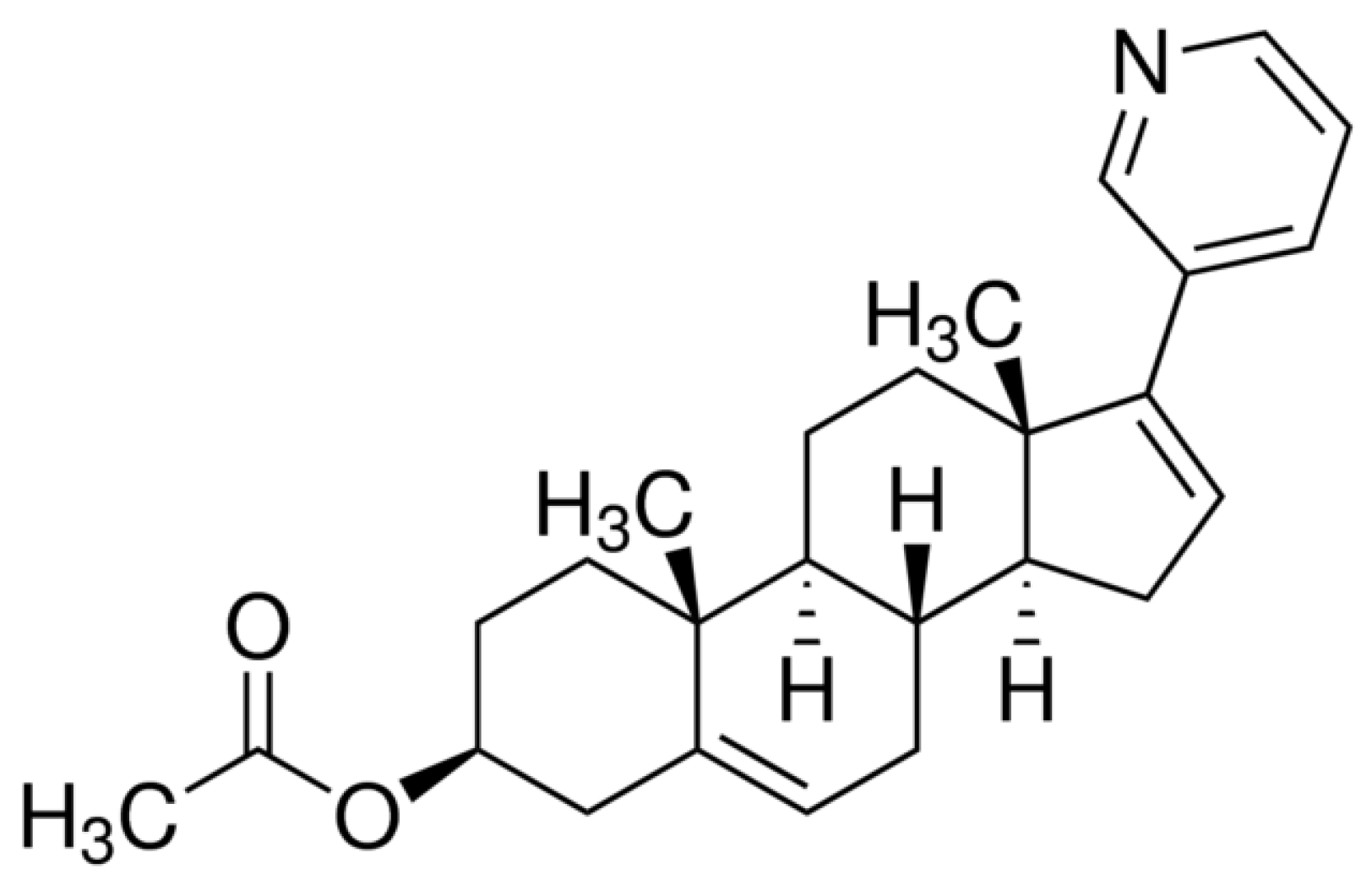

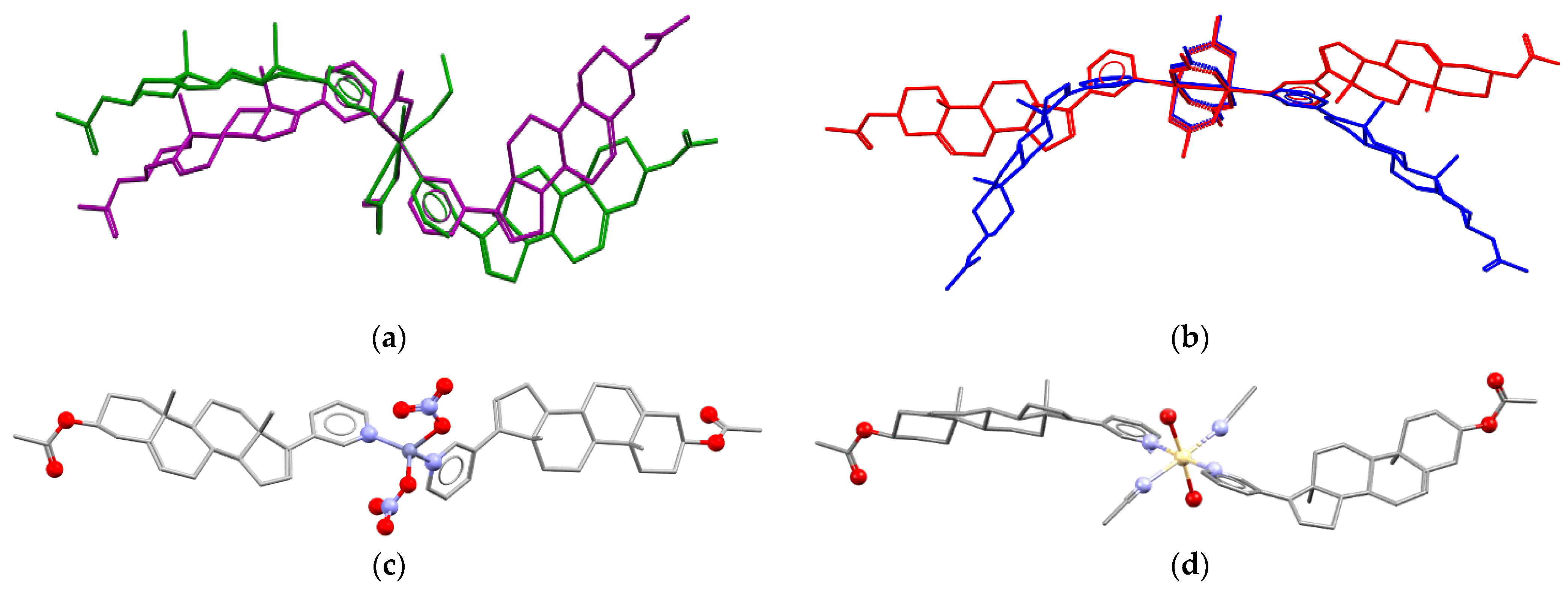
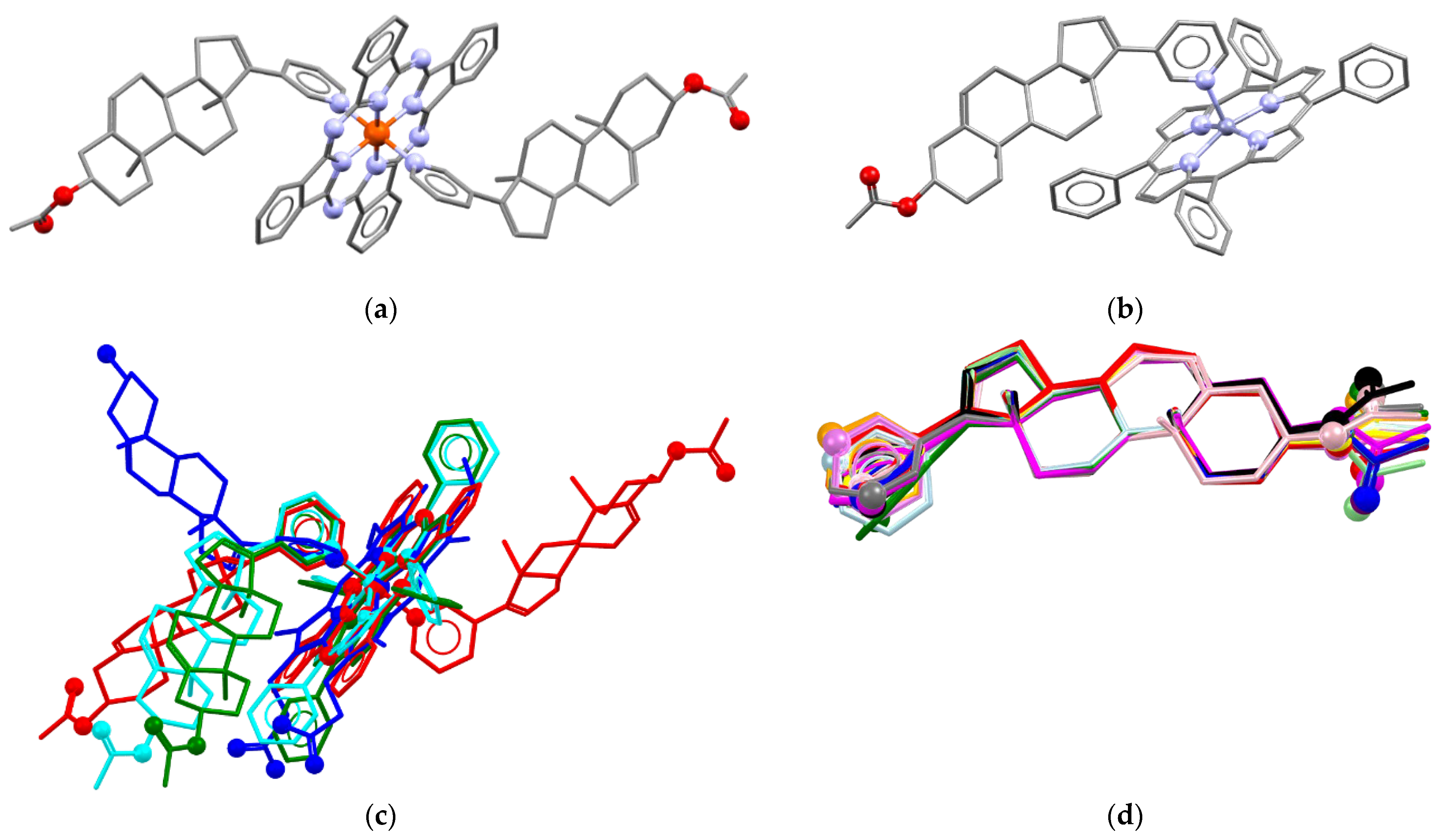


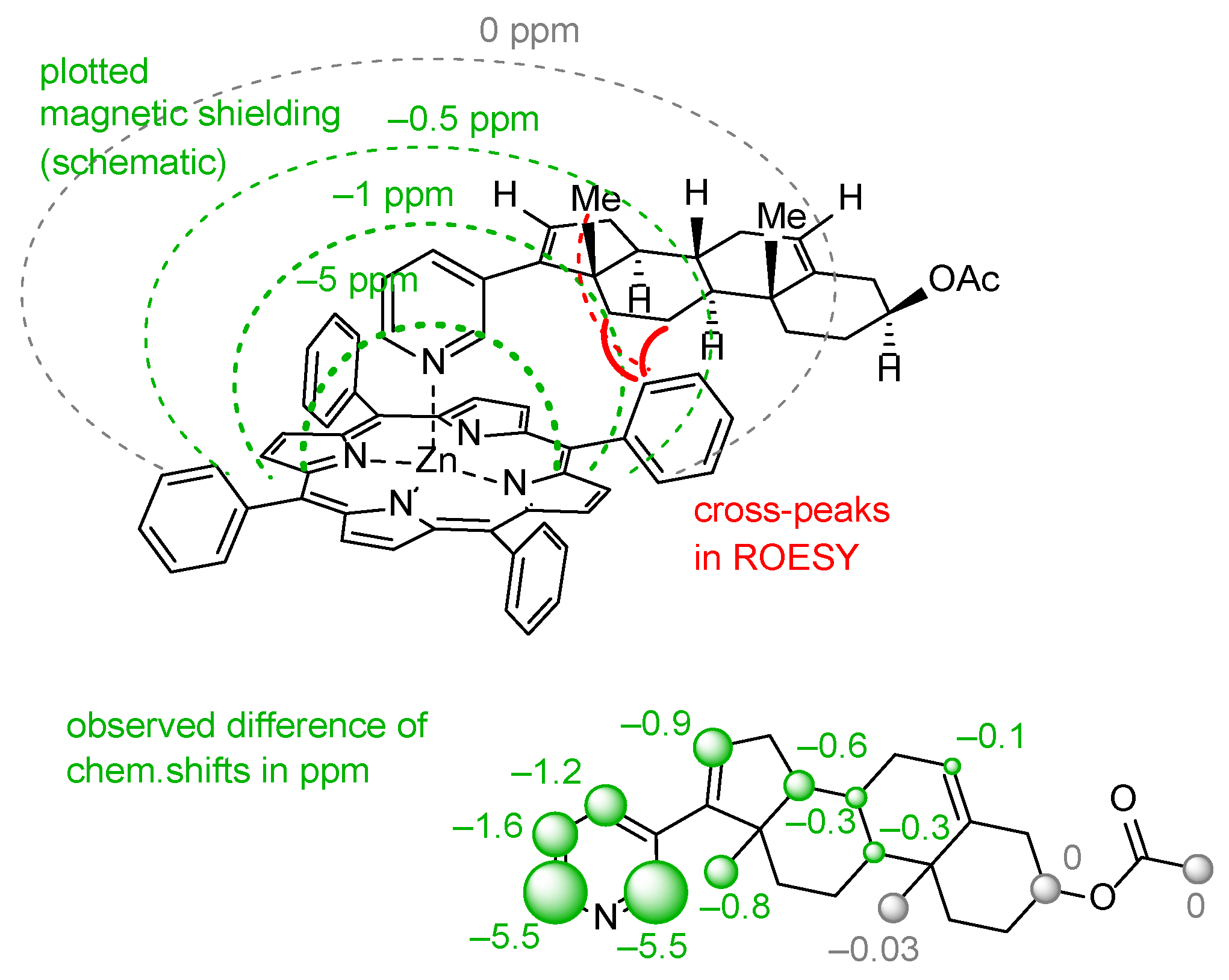
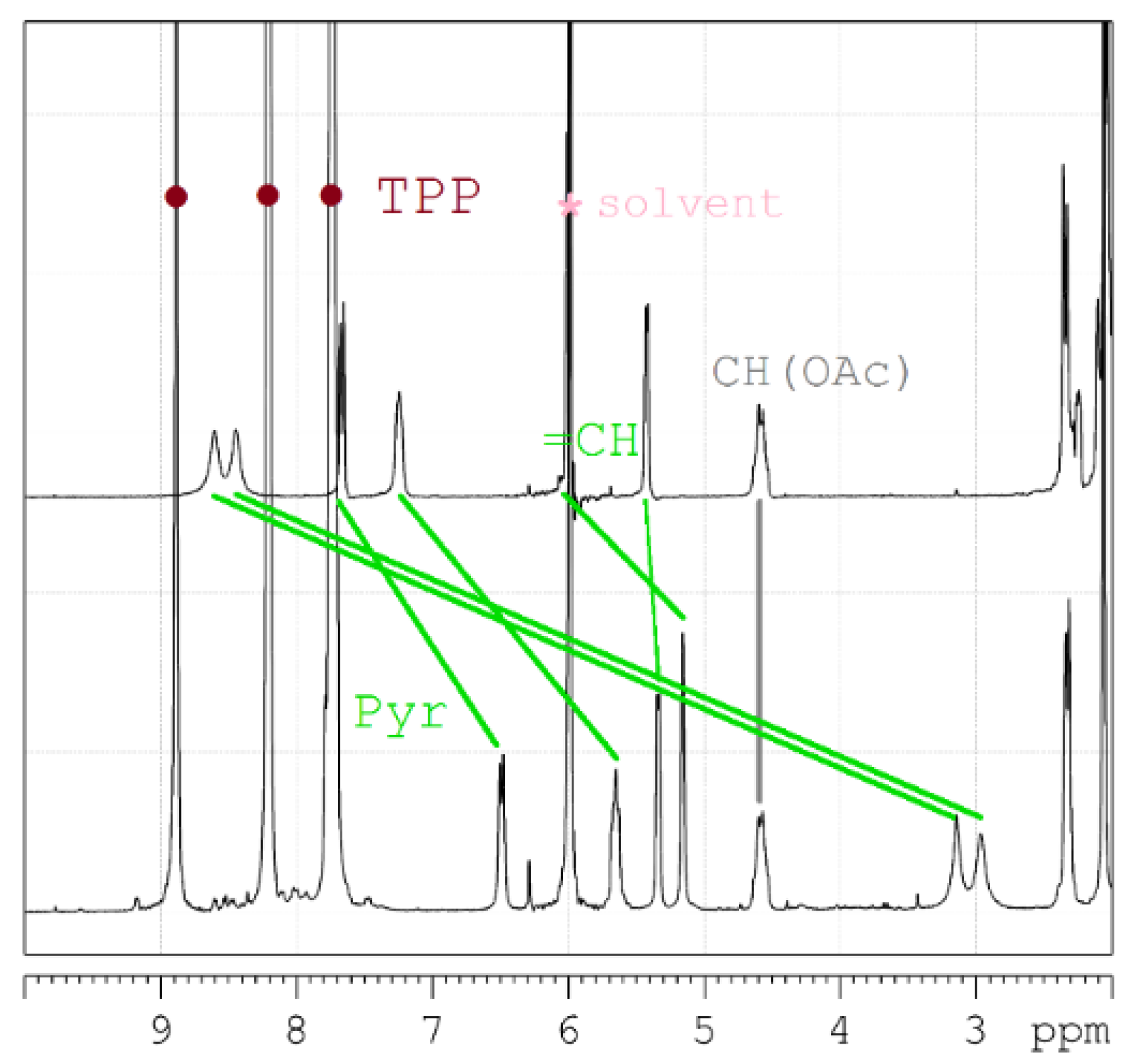
| CH3CN | THF | Et2O | EtOH | CH2Cl2 | Acetone | |
|---|---|---|---|---|---|---|
| AgNO3 | 1 a | – | – | 2 a | ↓ | ↓ |
| Cu(NO3)2·6H2O | 3 c | ↓ | ↓ | 4 c | ↓ | – |
| Cu(AcO)2·H2O | 5 b | 6 b | ↓ | ↓ | ↓ | ↓ |
| CuCl2·2H2O | – | – | ↓ | ↓ | ↓ | ↓ |
| Co(NO3)2·6H2O | 7 c | – | – | – | – | – |
| CoCl2·2H2O | – | – | ↓ | ↓ | ↓ | – |
| Ni(NO3)2·6H2O | 8 c | – | ↓ | ↓ | ↓ | – |
| Zn(NO3)2·6H2O | 9 c | – | – | – | – | – |
| Cd(NO3)2·4H2O | 10 c | – | – | – | – | – |
| Fe(AcO)2 | ↓ | – | – | – | ↓ | ↓ |
| FeBr3 | – | – | – | 11 b | – | – |
| FePC | 12 c | ↓ | ↓ | – | – | ↓ |
| ZnTPP | ↓ | ↓ | ↓ | 13, 14 d | – | ↓ |
| Cmpd | D—H···A | D—H | H···A | D···A | D—H···A |
|---|---|---|---|---|---|
| 3 | O14—H14A···O11 i | 0.87 | 2.001 | 2.795(9) | 152 |
| O14—H14B···O8 i | 0.86 | 2.026 | 2.761(8) | 143 | |
| 4 | O1—H1A···O8 | 0.93 | 1.729 | 2.631(12) | 164 |
| O1—H1B···O4 ii | 0.93 | 1.895 | 2.756(11) | 153 | |
| O2—H2···O11 i | 0.85 | 1.739 | 2.54(6) | 157 | |
| O3—H3A···O7 | 0.85 | 2.093 | 2.79(3) | 139 | |
| O3—H3B···O11 i | 0.85 | 1.910 | 2.75(3) | 167 | |
| O7—H7A···O8 | 0.85 | 2.287 | 3.12(3) | 168 | |
| O7—H7B··O13 iii | 0.85 | 2.147 | 2.78(3) | 131 | |
| 7 | O1—H1A···O5A | 0.87 | 1.928 | 2.785(5) | 170 |
| O1—H1B···O4A iv | 0.87 | 1.826 | 2.729(9) | 174 | |
| O2—H2A···O5 iii | 0.85 | 1.984 | 2.771(9) | 153 | |
| O2—H2B···O4 v | 0.85 | 2.169 | 2.884(8) | 142 | |
| 8 | O3—H3A···O7 | 0.81 | 2.163 | 2.90(1) | 153 |
| O3—H3B···O6 vi | 0.83 | 2.000 | 2.78(1) | 157 | |
| O4—H4A···O6A vii | 0.85 | 1.970 | 2.75(1) | 168 | |
| O4—H4B···O7A ix | 0.85 | 1.908 | 2.79(1) | 163 | |
| 10 | O1—H1B···O3 x | 0.86 | 2.339 | 2.780(8) | 157 |
| O1—H1C···O5A | 0.86 | 1.972 | 2.927(7) | 126 | |
| O2—H2A···O3A xi | 0.88 | 2.012 | 2.863(7) | 161 | |
| O2—H2B···O5A xii | 0.88 | 1.874 | 2.733(8) | 163 | |
| 11 | N1—H1···O2 xiii | 0.88 | 1.906 | 2.668(9) | 144 |
| 14 | O3—H3A···O2 xiv | 0.84 | 2.068 | 2.81(4) | 147 |
| Compd. | M | E(M–NPy) | E(M–NCH3CN) | E(M–OAn) | E(M–Oaqua) |
|---|---|---|---|---|---|
| 1 | Ag(I) | −109.3 | −111.6 | −63.7…−86.1 | |
| 2 | Ag(I) | −97.3…−97.5 | −56.5 | ||
| 5 | Cu(II) | −108.3…−108.9 | −114.8…−212.7 | ||
| 7 | Co(II) | −233.7…−235.5 | −211.2…−212.9 | −59.3…−60.8 | |
| 8 | Ni(II) | −148.5…−149.0 | −132.6…−134.2 | −105.3…−106.2 | |
| 9 | Zn(II) | −122.9…−123.3 | −98.2…−110.8 | ||
| 10 | Cd(II) | −100.9…−101.4 | −64.4…−66.4 | −56.8…−61.7 | |
| 12 | Fe(II) | −160.1…−162.8 | |||
| 13 | Zn(II) | −97.3 |
Disclaimer/Publisher’s Note: The statements, opinions and data contained in all publications are solely those of the individual author(s) and contributor(s) and not of MDPI and/or the editor(s). MDPI and/or the editor(s) disclaim responsibility for any injury to people or property resulting from any ideas, methods, instructions or products referred to in the content. |
© 2023 by the authors. Licensee MDPI, Basel, Switzerland. This article is an open access article distributed under the terms and conditions of the Creative Commons Attribution (CC BY) license (https://creativecommons.org/licenses/by/4.0/).
Share and Cite
Buikin, P.; Vologzhanina, A.; Novikov, R.; Dorovatovskii, P.; Korlyukov, A. Abiraterone Acetate Complexes with Biometals: Synthesis, Characterization in Solid and Solution, and the Nature of Chemical Bonding. Pharmaceutics 2023, 15, 2180. https://doi.org/10.3390/pharmaceutics15092180
Buikin P, Vologzhanina A, Novikov R, Dorovatovskii P, Korlyukov A. Abiraterone Acetate Complexes with Biometals: Synthesis, Characterization in Solid and Solution, and the Nature of Chemical Bonding. Pharmaceutics. 2023; 15(9):2180. https://doi.org/10.3390/pharmaceutics15092180
Chicago/Turabian StyleBuikin, Petr, Anna Vologzhanina, Roman Novikov, Pavel Dorovatovskii, and Alexander Korlyukov. 2023. "Abiraterone Acetate Complexes with Biometals: Synthesis, Characterization in Solid and Solution, and the Nature of Chemical Bonding" Pharmaceutics 15, no. 9: 2180. https://doi.org/10.3390/pharmaceutics15092180





